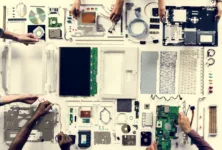Especially when people see self-driving cars and the capability to turn lights on from another room, they wonder what other innovations are out there. The medical field is full of them ranging from the ability to change stem cells into healthy tissue to needleless diabetes glucose testing. However, the construction field also has interesting inventions that may potentially alter how construction companies work in the future.
Benefits of Older Equipment
While equipment is much more cushy with air conditioning and a radio, traditional equipment works well. People find discounted construction equipment at finaldrivemotors.com that can withstand the test of time and heavy workloads. They consist of parts meant to last, so people find they often break down less than newer pieces of equipment.
Giant 3D Printer
Back in June 2017, Adam Kushner, a New York architect, created a gigantic military 3D printer. It crafted a 2,400-square-foot house. Additionally, the architect was able to use it to make a jacuzzi, carport, and a pool. The architect worked with D-Shape — a 3D printing company. Together, they produced a printer that combined sand, dust, gravel, and a binding agent to make a substance similar to marble. By the end of 2017, the first estate was generated using a 3D printer in the U.S. However, both China and the Netherlands already used this technology in the past. Ultimately, this innovation is important in the construction field because it could cut costs while heightening the quality of the materials.
Self-Driving Crash Trucks
In Coopersburg, PA, a construction equipment company revealed a self-driving crash truck. It will eventually be used by highway construction crews down in the “Sunshine State.” The vehicle doesn’t require a driver. It acts as a “crash truck” but doesn’t have a driver. This is because the person who drives a crash truck is always in danger.
Water-Absorbing Pavement
Storm waters are damaging to concrete. It begins to crack. However, a product known as Topmix Permeable may reduce the prevalence of damaged concrete. This particular concrete absorbs over 1,000 gallons of water per minute. It can ultimately reduce the pollution in streams, reservoirs, and rivers since it hinders the runoff from entering into water systems.
Robotic Construction Equipment
A Japanese construction equipment manufacturer noticed a shortage of laborers in the construction field. As a solution to this problem, the company created robotic crew members to compensate for the unfulfilled positions. Komatsu created drones that took video of construction sites. In addition, Komatsu made a team of driverless excavators. They use drones to guide them.
Self-Heating Concrete
Many construction projects require concrete, but it’s harmful to the environment because of the carbon it releases. Moreover, concrete has its share of issues like cracking as a result of water or chemicals. At the Bath University, researchers investigated a solution to these problems. As a result, they developed self-heating concrete. They discovered mixing bacteria with the concrete will cause it to germinate. When water enters a crack on in the cement, it will plug the crack with water and oxygen before further damage arises.
More Efficient Insulation
Heat transmission is a common problem in construction. The heat even goes into the drywall. When this occurs, it’s known as thermal bridging. Aerogel is a solution to this problem. Initially, aerogel was established for NASA as cryogenic insulation. As of today, it’s known as the most efficient insulation materials. The U.S. created a similar material known as Thermablock.
Photovoltaic Glazing
Photovoltaic glazing has the potential to assist buildings in generating their own energy source. Basically, this technology converts an entire building covered in it into a solar panel. The company Polysolar developed a transparent version of photovoltaic glazing used in building materials.For instance, companies currently use it to create roofs, windows, and facades. The version Polysolar created is strong enough to produce energy on north-facing surfaces as well as vertical walls. It has a high-performance rating.
Kinetic Energy-Powered Items
Kinetic energy is the energy humans use each day — motion. A startup company in Italy explored the use of kinetic energy in roadways. The company established a rubber paving that changes kinetic energy from the motion of vehicles into another form of energy — electrical. Basically, this technology utilizes the concept that braking disperses kinetic energy.








